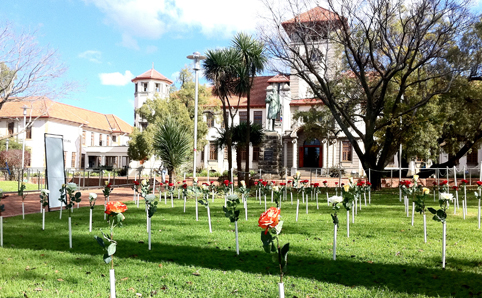Latest News Archive
Please select Category, Year, and then Month to display items
20 December 2020
|
Story Thabo Kessah
|
Photo Thabo Kessah
 Mbuyiselwa Moloi with student volunteers, Keamogetswe Mooketsi (presenter), Tshumelo Phaladi (producer), and Siphamandla Shabangu (SRC member – Social Justice and Universal Access).
Mbuyiselwa Moloi with student volunteers, Keamogetswe Mooketsi (presenter), Tshumelo Phaladi (producer), and Siphamandla Shabangu (SRC member – Social Justice and Universal Access).
The month of October 2020 marked the first anniversary of the Qwaqwa Campus online student radio, Q-Lit. “It has been a rocky road of sleepless nights, tears, and a lot of challenges. However, we have grown from strength to strength. We have made dreams of ordinary students possible. We have influenced change and inspired students to tap into their talents and potential,” said an elated station manager, Mbuyiselwa Moloi.
The station came in handy during the worst lockdown period of the COVID-19 pandemic when it bridged the communication gap between students and the university to integrate teaching and learning into the programming to ensure that no student was left behind. “With all of the regulations and online learning, Q-Lit had to be reinvented. While it was not an easy journey, we have grown more than ever before. Our August 2020 report shows that we have pulled in more than 1 600 listeners, even amid the learning, unlearning, and relearning processes. It was during this month that we also ran a series highlighting strategic offices led by women on campus as part of our Women’s Month celebration,” Mbuyiselwa revealed.
Looking to the future, the station hopes to obtain a full broadcasting licence from the regulatory body, the Independent Communication Authority of South Africa (ICASA), soon.
“Month of Compassion”
2011-05-24
 |
|
Hundred roses were planted in front of our Main Building
Photo: Duard Grobbelaar
|
The Health and Wellness Centre at our university recently planted roses on the Main Campus in memory of people who passed away in the past year due to some illnesses and other personal issues.
Each rose represented 2 550 South Africans who have passed away and 100 roses were planted in front of the Main Building on our Main Campus. There were 51 red roses which represented deaths due to HIV, 14 yellow roses for those who passed away due to ischemic heart disease, 13 white roses for deaths caused by stroke, 11 orange roses for deaths caused by turbeculosis and 11 pink roses for deaths caused by interpersonal violence.
The rose garden managed to draw a lot of attention and people, many of which were members of our own staff and several students, actually took time from their busy schedules to have a look at its spectacular beauty.